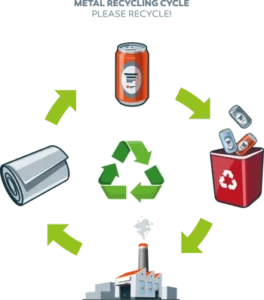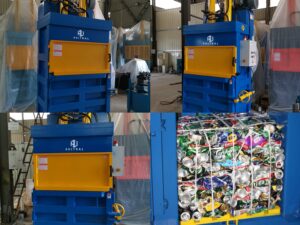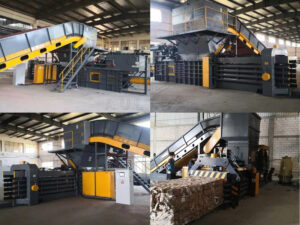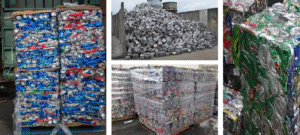Introduction
Every year, millions of tons of cardboard are thrown away, even though it’s one of the most valuable recyclable materials. If you’ve ever sold old boxes to a scrap dealer, you may have noticed that some places pay more than others. The secret? Baling machines.
These powerful machines compress loose cardboard into dense, easy-to-transport blocks, increasing its value by up to 30% or more. Whether you’re a homeowner, small business, or recycling center, understanding how baling works can help you maximize profits from cardboard waste.
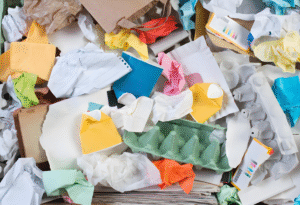
Why Is Cardboard So Valuable?
Cardboard is made from wood pulp, and recycling it saves trees, energy, and water. Because of high demand from packaging companies, recycled cardboard (called OCC, or Old Corrugated Containers) is a billion-dollar industry.
-
Recycling 1 ton of cardboard saves 17 trees and 7,000 gallons of water.
-
Corrugated cardboard can be recycled 7-10 times before fibers break down.
-
China, India, and the U.S. are the biggest importers of recycled cardboard.
But there’s a catch: Loose, un-baled cardboard is harder to sell at top prices.
The Problem with Loose Cardboard
If you’ve ever tried stacking flattened boxes in your garage or truck, you know how much space they take up. For recycling centers and scrap buyers, transporting uncompressed cardboard is inefficient because:
✅ Takes up too much truck space – A truckload of loose cardboard might weigh only a few tons, while baled cardboard can carry 3-5x more per trip.
✅ Higher labor costs – Workers spend more time stacking and handling loose material.
✅ Lower market price – Scrap dealers pay less for uncompressed cardboard because processing costs are higher.
This is where baling machines come in.
How Baling Machines Increase Cardboard’s Value
A baling machine uses hydraulic pressure to crush cardboard into compact blocks (called “bales”), typically weighing 500-1,000 lbs each. Here’s how it boosts profits:
1. Higher Price per Ton
-
Loose cardboard might sell for $50-$80 per ton.
-
Baled cardboard can fetch $100-$150 per ton because it’s easier to process.
2. Lower Transportation Costs
-
A single truck can carry 10+ tons of baled cardboard vs. only 3-4 tons of loose cardboard.
-
Fewer trips mean lower fuel and labor costs for recyclers.
3. Less Storage Space Needed
-
A bale takes up 80-90% less space than loose cardboard.
-
Warehouses and recycling centers can store more material before selling.
4. Cleaner & More Marketable
-
Baling removes air, making cardboard less likely to blow away or get contaminated.
-
Buyers prefer uniform bales for consistent paper quality.
Types of Baling Machines for Cardboard
Not all balers are the same. Depending on your needs, you can choose from:
1. Vertical Balers (Best for Small Businesses/Homes)
-
Capacity: 100-500 lbs per bale
-
Cost: $3,000-$10,000
-
Good for: Grocery stores, retail shops, households with lots of Amazon boxes
2. Horizontal Balers (Industrial Use)
-
Capacity: 1,000-2,000 lbs per bale
-
Cost: $20,000-$100,000+
-
Good for: Recycling centers, large warehouses, factories
3. Portable Balers (For Mobile Recycling)
-
Fits on a truck or trailer
-
Used by junk removal services
How to Start Baling Cardboard for Profit
If you generate a lot of cardboard waste (or can collect it from neighbors/businesses), here’s how to turn it into cash:
Step 1: Collect & Sort
-
Remove tape, stickers, and food stains (contaminated cardboard sells for less).
-
Flatten boxes to save space before baling.
Step 2: Choose the Right Baler
-
For home/small business: A used vertical baler (check Craigslist or auctions).
-
For large-scale recycling: Lease a horizontal baler.
Step 3: Find Buyers
-
Local scrap yards – Call ahead for pricing.
-
Paper mills & packaging companies – Some buy directly.
-
Online recycling marketplaces – Platforms like RecycleMatch connect sellers with buyers.
Step 4: Optimize for Maximum Profit
-
Bale density matters – The tighter the bale, the more buyers will pay.
-
Sell in bulk – Buyers offer better rates for truckloads (20+ tons).
-
Time your sales – Cardboard prices fluctuate; track market trends.
Real-Life Success Stories
-
A small grocery store in Ohio installed a vertical baler and now earns $500/month from cardboard recycling.
-
A junk removal company in Texas added a portable baler to their truck, increasing profits by 40% on cardboard hauls.
-
A school district in California reduced waste disposal costs by 60% after baling their cardboard instead of trashing it.
Conclusion: Is Baling Worth It?
If you throw away cardboard regularly, you’re literally throwing away money. Even a small $3,000 vertical baler can pay for itself in 6-12 months if you collect enough material. For businesses, recycling baled cardboard can be a new revenue stream, while homeowners can make extra cash by selling to local scrap dealers.
The next time you break down an Amazon box, think: Could this be worth more if I baled it? The answer is almost always YES.

